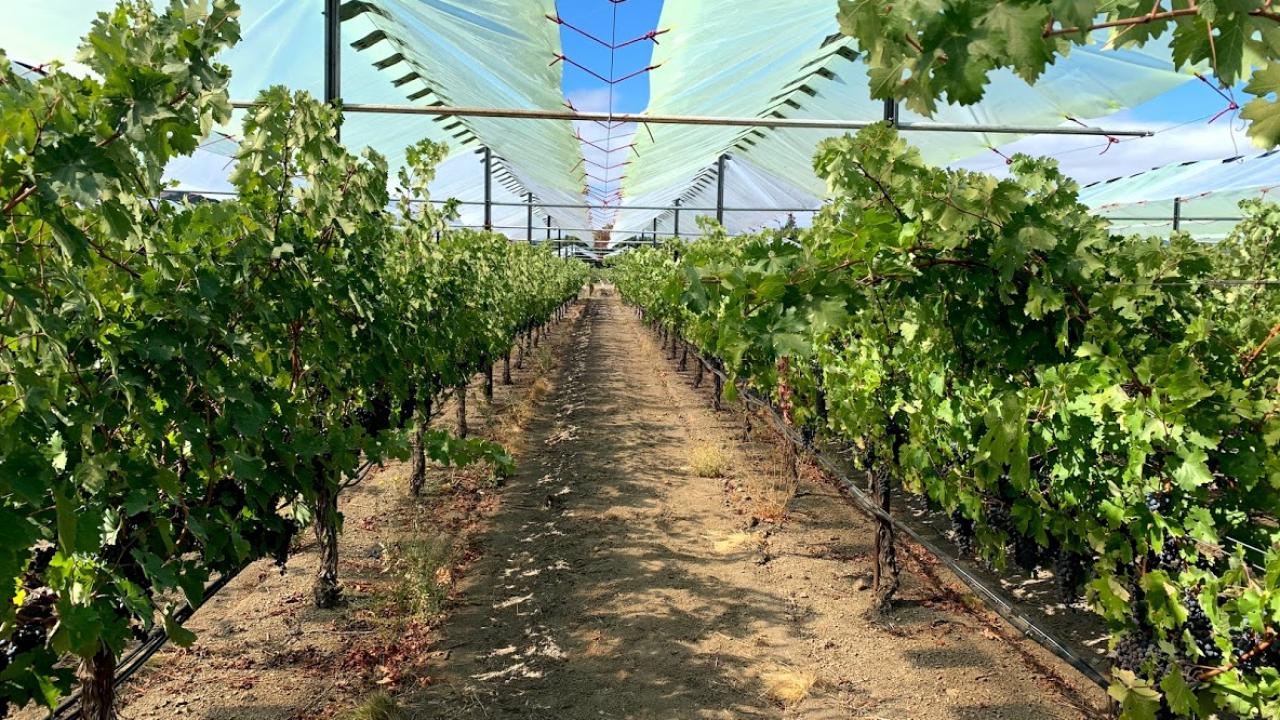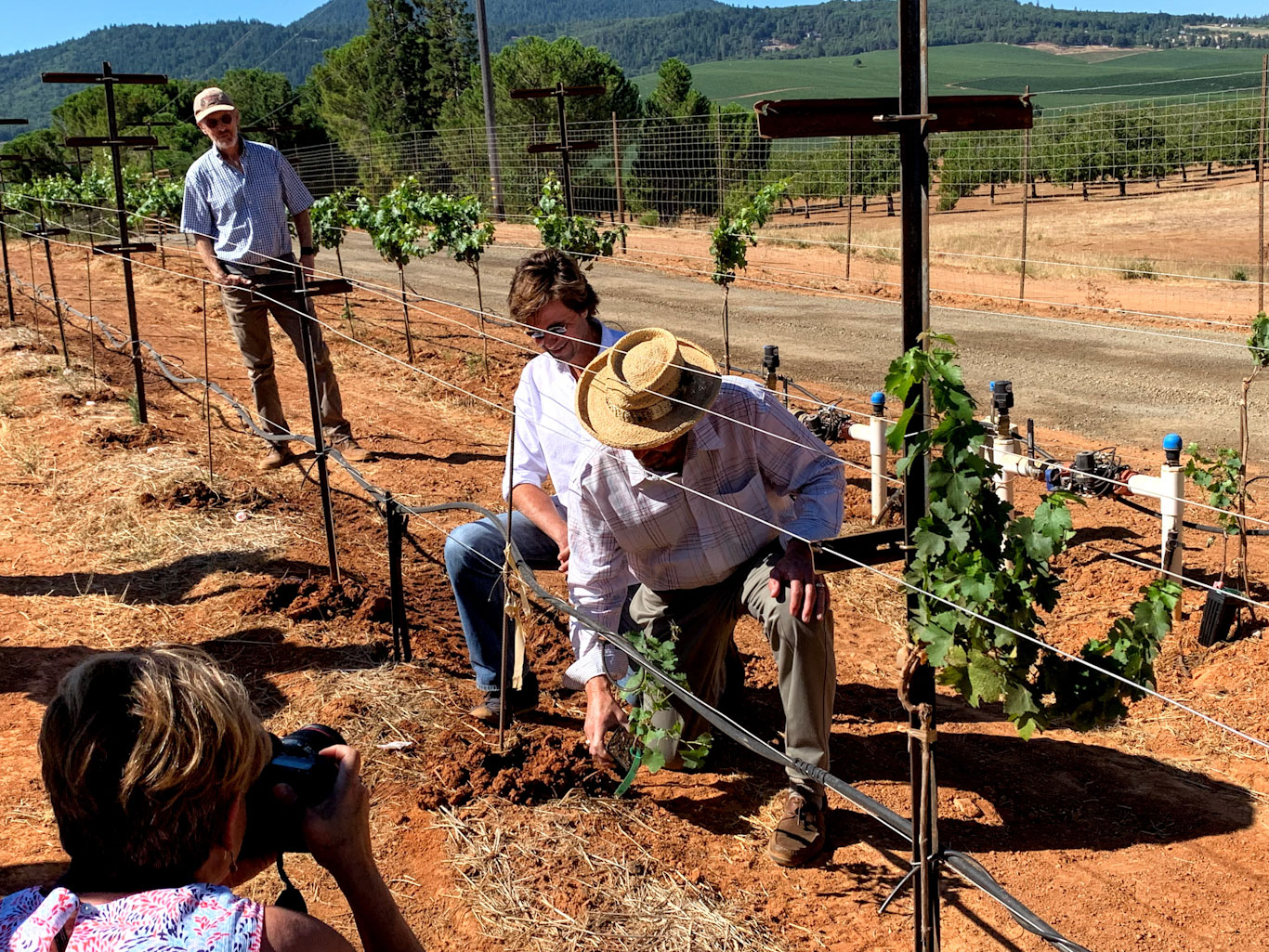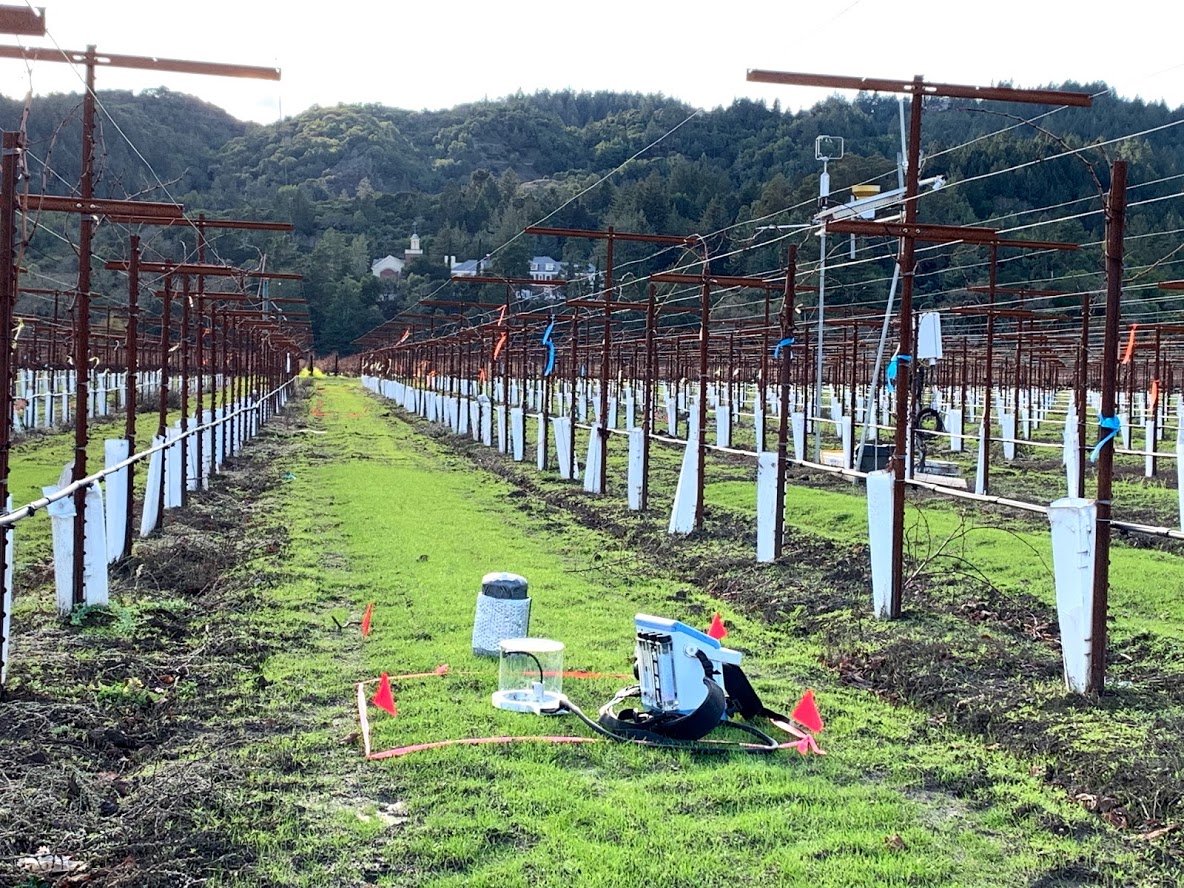
Cooperative Extension Specialist Dr. Kaan Kurtural reports on the latest research from his lab at the UC Davis Experimental Vineyard in Oakville, which focuses on climate change via four large scale trials. Read his update here:
The commercial success of a viticultural region is based on a delicate balance between the climate, cultivar, and rootstock selection, combined with an adequate market demand. By the middle of the 21st century, climatic conditions are expected to change to potentially affect key physiological and production parameters. The increase in CO2 and other greenhouse effect gasses to the atmosphere most certainly will increase the temperature of the planet ranging from 1.5 to 4.5°C. Furthermore, the occurrence of extreme weather events, such as heat waves, is increasing with an associated risk for grapevines. Higher temperatures are associated with higher rates of evaporation of water from surfaces and therefore, higher global precipitation events, albeit these are unevenly distributed. In fact, most regions where grapes are grown are forecasted to experience a reduction in cloud coverage and rainfall and an increase in solar radiation reaching the earth’s surface. In order to mitigate these effects of climate change in commercial viticulture, we have undertaken four large scale trials in collaboration with our industry supporters at the Napa Valley Grape Growers, and colleagues in the Department of Land Air and Water Resources.
Innovative mechanized trellis systems for coastal viticulture. In this trial we are testing innovative trellis and conduction systems on how they may palliate the effects of extreme temperatures on the Cabernet Sauvignon grape berry. We are investigating six different trellis systems ranging from single-plane bilateral cordon vertically shoot-positioned systems to high-quadrilateral systems that can separate the canopy horizontally up to 48-inches. Based on our recent discovery of using the mono-substituted flavonol as the biomarker for over exposure of grape berries in red wine grape (https://bit.ly/2MocfFO), our hypothesis is that we will find the sweet spot for correct solar radiation exposure for red wine grapes in coastal regions. We will conduct the first commercial harvest and vintage from this trial in 2020.

Investigating resiliency of Cabernet clone and rootstock combinations. In this trial we are investigating 100 combinations of clones and rootstocks in a commercial vineyard to assess their resilience to droughts and simulated heat waves. After much discussion with industry partners; growers, county commissioners, members of CAWG, wineries, and nurseries it was decided that there would be little to no commercial interest in the market place to sustain family farms with the introduction of new cultivars in California. The trial includes clones of Cabernet Sauvignon that are previously untested in research trials (10 clones) as well as 10 rootstocks some of which are new USDA releases that are also untested for proper viticultural and enological evaluation. This experiment is being conducted in collaboration with large scale premium growers, nurseries and our laboratory at the UC Davis Oakville Experimental Vineyard. In our previous work we developed a biomarker that can give us the season-long picture of the stomatal conductance or plant water status of the grapevine (Brillante et al. 2020, Frontiers in Biogeosciences). We will use this biomarker to assess the resiliency of the 10 x 10 clone and rootstock combination to drought and heat stress in addition to our routine agronomic and biochemical assessment of the crop and wine.

Low maintenance cover cropping and no-till systems to mitigate carbon sequestration and greenhouse gas emissions in vineyard systems. For this work my lab is collaborating with the Napa Valley Grape Growers, The Wine Group, Nichols Farms and NextWatts Inc. to study the use of cover crops Radix Poa bulbosa (RPb), a barley cover crop, and native vegetation (control) under tillage and no-tillage systems in vineyards and pistachio orchards for three growing seasons. In terrestrial nutrient cycles, about half of the carbon emitted to the atmosphere originates from heterotrophic respiration on or in surface soils, while nearly all of the nitrogen (N) emitted is derived from soil-based microbial processes near the soil surface. Edaphic changes caused by management can strongly affect this cycling. In particular, tillage management and the use of cover crops can alter the production and consumption of the three primary biogenic greenhouse gases (GHGs) that include C and N: carbon dioxide (CO2), methane (CH4), and nitrous oxide (N2O). Cover-cropping and reduced tillage are considered the major means available, and they may have great potential in the open areas of permanent cropping systems such as almonds, grapes and pistachios. Permanent cropping systems have not received the same attention as have annuals, despite their high potential to sequester carbon into soil. The study was established with experiments in California from Napa to Tulare County. With the invaluable assistance of my colleagues from Land Air and Water Resources Drs. Cristina Lazcano and Daniele Zaccaria, we have started collecting the initial carbon sequestration and greenhouse gas emissions data at the Oakville Station site.

Selective spectral solar radiation filtration and precipitation exclusion in coastal vineyards. In this fundamental trial that we are conducting in a producing vineyard at the Oakville Station, we are following up on our previous solar radiation exclusion work. Fruit exposure to solar radiation was highlighted for decades as a key factor to enhance ripening of fruits and their composition. This is very relevant for cultural practices in grapes. Fruit zone leaf removal in dense canopies can promote ripening and synthesis of flavonoids such as anthocyanins and flavonols. Under controlled conditions, a combination of visible and UV radiation may upregulate structural and regulatory genes responsible for the synthesis of anthocyanins and flavonols. These photomorphogenic effects are mediated by photoreceptors, phytochromes and cryptochromes and are responsive to changes in radiation spectra. However, solar radiation, especially infrared, transmits thermal energy to exposed objects with an intrinsic increase in their temperature. High temperature may play a repressive role in the synthesis of anthocyanins, eventually inducing their degradation. In our previous research, qualitative and quantitative differences in microclimate were induced by means of color shade nets (see https://bit.ly/2ENlHOE). We followed up this work by designing an experiment aiming to test the effect of partial solar radiation reduction and irrigation amounts and their interaction on gas exchange, stem water potential, berry temperature, must composition, and skin anthocyanins and flavonols. We then evaluated the vulnerability of Cabernet Sauvignon grape berries to solar radiation overexposure and tested whether increased water availability would palliate either high berry temperatures or deleterious effects on grape composition. In our previous works we deduced that although grapevines responded to transiently increased applied water amounts with greater stem water potential, plants with partial fruit zone shading had better plant water status throughout the growing season with minimal anthocyanin degradation and yield loss (Annals of Applied Botany Martínez-Lüscher et al. 2020. In press.). Currently we are working with plastics and trellis manufacturers to design and install novel systems in producing vineyards. We are now comparing four different solar radiation exclusion regimes to untreated control. What is interesting about this trial is that the plants under protective covers are also excluded from precipitation but will only receive supplemental irrigation within the season. The plastics are able to modulate the radiation environment from excluding UVA to UVC as well as the NIR range, with some modulation within the photosynthetically active range. This work will allow us to deduce the correct combinations of solar radiation spectra and applied water amounts to mitigate effects of climate change for red wine grape in coastal regions.
